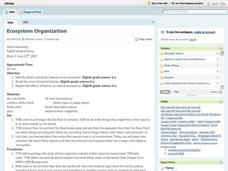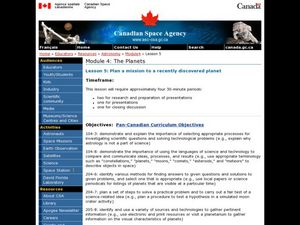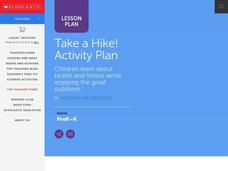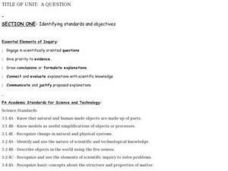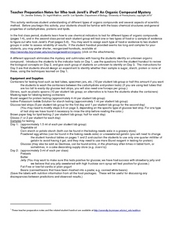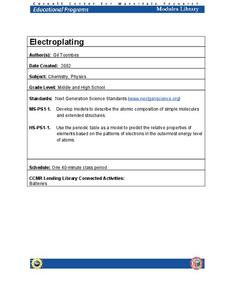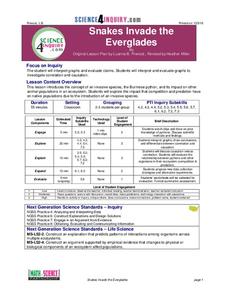Curated OER
Ecosystem Organization
Eighth graders engage in a lesson about ecosystems with the intention of looking at how it is organized. They cover the biotic and abiotic factors of an ecosystem while looking at the seven types of terrestrial biomes. Students write...
Curated OER
Plan a Mission to Recently Discovered Planet
Pupils plan a mission to a recently discovered planet. In this science lesson, students research spacecraft design, distances in space, long-term missions in space, and life-sustaining planets. Pupils work in groups to research an...
Curated OER
Earth and Sun's Distance
Students consider the shape of the Earth's orbit around the Sun. They view the first segment of Science Court video and use Timeliner software to construct a scale of the distance between the Earth and the Sun.
Curated OER
Dem Bones
Students engage in an activity in order to review the skeletal system. They play a game composed of two teams to be played in an open area. Students pick out bones from a bag and place them in the correct space for the skeleton.
Curated OER
Industrial Processes of Polymers: How toys Are Made
Students explore how technology and science have created the plastics that make toys. In this industrial processes instructional activity students work on their own injected molded product and a blow molded product.
Curated OER
Take a Hike!
Students explore the benefits of staying active by going on a hike. In this physical education lesson, students discuss the concept of a hike, where a good place to hike is and what types of foods are necessary to stay nourished....
Curated OER
The Nitrogen Cycle
Young scholars study the nitrogen cycle and construct a diagram. In this Earth Science lesson students use role play to see the various paths.
Curated OER
Making Ice Cream
Student examine the physical changes of matter and are able to describe them. They make ice cream in plastic bags to observe the changes in matter. They describe and record the changes in the ice cream mixture as it freezes.
Curated OER
A QUESTION
Students engage in scientifically oriented questions. They give priority to evidence, draw conclusions/formulate explanations and connect/evaluate explanations with scientific knowledge. Students communicate and justify proposed...
Curated OER
Wind Power: From Eyesore to Energy
Students design their own wind turbine according to client's needs. In this science and technology lesson, students analyze the pros and cons of using wind power. They construct a model of their proposed wind turbine and present it to...
Curated OER
Who Took Jerell's iPod?
Young scholars investigate various substances to determine the perpetrator of a crime. In this biology lesson, students test for the presence of organic compounds in various samples. They identify an unknown substance based on its...
Curated OER
Teaching Animal Rights
In this biology worksheet, students engage in the reading of the rights of educators to teach concerning the issue of using animals for educational purposes.
Curated OER
The Seasons
Discover the change of the seasons by modeling the Earth-Sun system. Learners model the orbit of the Earth around the sun and explore how and why the patterns of winter and summer occur.
Curated OER
Why Do We Need Exercise?
Discuss the importance of exercise with your middle schoolers using this PowerPoint. Actively engage them by surveying how they spend their free time and explain many benefits of physical activity. Learners consider what they did over...
Curated OER
Solstice And Equiniox Curriculum
Students engage in a instructional activity that investigates finding the dates of the solstices and equinoxes. They define the terms related to the concept and conduct research in order to explain the physical occurrences. They also...
Curated OER
The Human Pendulum
Students explore the pendulum. In this physics activity, students investigate how length, amplitude and mass affect the period of a pendulum. The students will engage in an exploratory activity in order to best grasp the concepts of...
Curated OER
Wig-wag Physics
Learners make observations on the effects of a small, medium and large weight on the movement of a wig-wag apparatus. They use their observations to develop a generalized inference of the effect weight on movement patterns.
Curated OER
Science: Exploration Tubs
First graders develop skills of scientific inquiry. They determine which objects float and which sink.
Cornell University
Catapults
Ready, aim, fire! Launch to a new level of understanding as scholars build and test their own catapults. Learners explore lever design and how adjusting the fulcrum changes the outcome.
Cornell University
Beam Focusing Using Lenses
Explore optics using an inquiry-based experimental approach! Young scholars use a set of materials to design and build a unit capable of focusing a beam of light. They experiment with different lenses to determine the best approach to...
NASA
Revising an Investigation
Write, edit, and then revise! The fourth lesson plan in a five-part series asks peers to provide feedback on research. Individuals then use the research to edit and revise conclusions and develop their presentations.
NASA
The Discovery of Jupiter Radio Waves
Lead your class on a journey to the planet Jupiter and provide them with fun facts in the process. Learners explore radio waves emitted by Jupiter to further understand how this data helps our daily lives. They conclude by discussing...
Cornell University
Electroplating
Silver pennies and copper nickels are made possible by applying some chemistry. Learners use electrolysis to coat a penny with zinc sulfate and a nickel with copper sulfate. Their investigation builds an understanding of electroplating...
Science 4 Inquiry
Snakes in the Everglades
The Burmese python is on the loose ... and he's hungry! Illustrate the differences between causative and correlative relationships through an inquiry lesson. Pupils examine several sources of information to determine if there is a...
